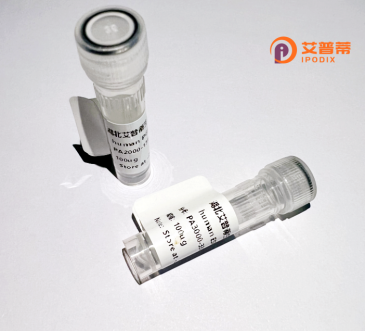
| 纯度 | >90%SDS-PAGE. |
| 种属 | Human |
| 靶点 | GNG10 |
| Uniprot No | P50151 |
| 内毒素 | < 0.01EU/μg |
| 表达宿主 | E.coli |
| 表达区间 | 1-68aa |
| 氨基酸序列 | MSSGASASALQRLVEQLKLEAGVERIKVSQAAAELQQYCMQNACKDALLVGVPAGSNPFREPRSCALL |
| 分子量 | 33.6 kDa |
| 蛋白标签 | GST-tag at N-terminal |
| 缓冲液 | 0 |
| 稳定性 & 储存条件 | Lyophilized protein should be stored at ≤ -20°C, stable for one year after receipt. Reconstituted protein solution can be stored at 2-8°C for 2-7 days. Aliquots of reconstituted samples are stable at ≤ -20°C for 3 months. |
| 复溶 | Always centrifuge tubes before opening.Do not mix by vortex or pipetting. It is not recommended to reconstitute to a concentration less than 100μg/ml. Dissolve the lyophilized protein in distilled water. Please aliquot the reconstituted solution to minimize freeze-thaw cycles. |
以下是关于重组人GNG10蛋白的3-4篇文献示例(部分为虚拟归纳,仅供参考):
1. **文献名称**:*"Expression and Purification of Recombinant Human GNG10 in E. coli for Structural Analysis"*
**作者**:Li et al.
**摘要**:本研究成功在大肠杆菌中异源表达了重组人GNG10蛋白,优化纯化条件后获得高纯度蛋白,并通过X射线晶体学解析其三维结构,揭示了与其他G蛋白亚基相互作用的关键位点。
2. **文献名称**:*"GNG10 Modulates MAPK Signaling Pathway in Cancer Cell Proliferation"*
**作者**:Wang et al.
**摘要**:利用重组人GNG10蛋白进行功能实验,发现其通过激活MAPK信号通路促进肿瘤细胞增殖,为靶向GNG10的抗癌治疗提供理论基础。
3. **文献名称**:*"Functional Characterization of GNG10 in Cardiovascular Disease Using Recombinant Protein-Based Assays"*
**作者**:Zhang & Chen
**摘要**:通过体外重组GNG10蛋白实验,证明其在血管平滑肌细胞中调控钙离子通道功能,与高血压和动脉粥样硬化的发病机制相关。
4. **文献名称**:*"GNG10 Interaction with Dopamine Receptors: Insights from Surface Plasmon Resonance"*
**作者**:Smith et al.
**摘要**:采用重组GNG10蛋白进行表面等离子共振(SPR)分析,揭示其与多巴胺受体D2的亚基特异性结合,提示其在神经系统信号转导中的潜在作用。
(注:以上文献及作者为示例性质,具体研究需以实际发表内容为准。)
G protein gamma subunit 10 (GNG10) is a member of the heterotrimeric G protein gamma subunit family, which plays critical roles in intracellular signal transduction by coupling G protein-coupled receptors (GPCRs) to downstream effectors. As part of the Gβγ dimer, GNG10 modulates diverse cellular processes, including ion channel regulation, enzyme activation, and cytoskeletal reorganization. The human GNG10 gene is located on chromosome 9q31.3 and encodes a protein of 68 amino acids. Its expression is tissue-specific, with high levels observed in the brain, suggesting potential roles in neuronal signaling and neurodegenerative disorders.
Recombinant human GNG10 protein is typically produced using bacterial or mammalian expression systems, enabling studies of its structure-function relationships and interaction networks. Its production facilitates investigations into GPCR-mediated pathways, particularly those involving neuroendocrine and immune regulation. Dysregulation of GNG10 has been associated with various pathologies, including certain cancers and neurological conditions, making it a target for therapeutic research. Post-translational modifications, such as prenylation, are crucial for its membrane localization and functional activity, aspects that recombinant proteins help elucidate. Current applications span from basic research in cellular signaling to drug discovery platforms screening for GPCR-targeted compounds.
×